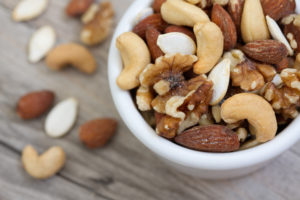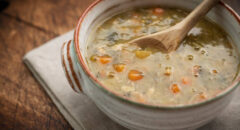
Did you know there is more to managing diabetes than good blood sugar control? Diabetes management also includes control of your blood pressure, cholesterol levels, and body weight. Together, these factors are often referred to as the ABCs of diabetes management. Scientific evidence suggests eating peanuts, and certain tree nuts may help with diabetes management when consumed as part of a diet that is nutritionally adequate and within calorie needs.
"Nuts can be part of a healthy diet offering ways to bump up fiber, protein, beneficial fatty acids, B vitamins, carotenoids, and antioxidants," says New York-based registered dietitian, certified diabetes educator Marlisa Brown, MS, RD, CDE, CDN. However, when it comes to diabetes, some nuts are better than others.
Here are the five best nuts for diabetes management.
Almonds
Almonds are especially useful for people with diabetes because they are high in magnesium. Studies show that a low level of magnesium intake is associated with an increased risk of developing type 2 diabetes.
"Also, there's evidence that almonds can help manage blood sugar levels and reduce heart disease," says Brown, a spokesperson for the American Association of Diabetes Educators. "In a recent study, when adults with type 2 diabetes followed an almond rich diet for 24 weeks, they experienced a significant decrease in HbA1C, waist size, triglycerides, and LDL cholesterol.”
Cashews
Cashews are higher in calories compared to other nuts, but they still provide benefits for people with diabetes. Toby Smithson, MS, RDN, LD, CDE, Diabetes Lifestyle Expert and vlogger at DiabetesEveryDay says "even though cashews are higher in calories and lower in fiber per serving than other nuts, they contain heart-healthy vitamins such as potassium, vitamin E, B6, and folic acid.
In a 2018 study, researchers investigated the effects of cashew nuts in adults with type 2 diabetes. Participants in the study were given either a cashew enriched diet or a typical diabetes diet for 12 weeks. At the end of the study, those on a cashew-enriched diet had lower blood pressure and higher levels of HDL cholesterol (good cholesterol). High blood pressure and low levels of HDL cholesterol are risk factors for heart disease.
Peanuts
Peanuts can reduce the risk of diabetes and help control blood sugar in individuals already diagnosed with diabetes. "Studies have shown eating plant protein, including peanuts and peanut butter, can reduce type 2 diabetes risk by 9% compared to people who consume a higher animal protein diet. Those following an animal-based meal plan had a thirteen percent increased risk of type 2 diabetes,” says Smithson. “Peanuts contain the amino acid arginine which helps open blood vessels to increase blood flow for heart health and causes the body to release more insulin which helps stabilize blood sugar levels,"
Pistachios
Pistachios are associated with improved blood sugar control in people with type 2 diabetes and prediabetes. "Pistachios have higher concentrations of fiber, both soluble and insoluble. Fiber helps slow absorption of carbohydrate and reduce cholesterol levels," says Smithson, author of Diabetes Meal Planning and Nutrition for Dummies.
Pistachios can also help with weight reduction and weight maintenance. Ounce per ounce compared to other nuts, pistachios are lower in calories. "Also, if you eat pistachios in the shell, it helps with mindful eating, so you are more aware of how many nuts you are eating. Pistachios in shell give you the visual cue of how much you have consumed," says Smithson.
Walnuts
"Walnuts contain Omega 3 fatty acids which can help lower triglycerides and raise HDL cholesterol," says Brown. "Compared to other nuts, walnuts contain the highest amount of omega 3 fatty acids." Studies show eating two ounces of walnuts daily improved both blood sugar and cholesterol in people with type 2 diabetes.
Moreover, in a 2018 study, researchers investigated the association between walnut consumption and diabetes risk in 34,121 people. The study found walnut consumers showed a lower risk for diabetes compared with those who did not eat walnuts.
Brown says it's easy to incorporate nuts into a meal plan. "Some ideas include: Adding nuts as a topping for yogurt, sprinkled into cereal, ground into a crust topping, mixed with dried fruit or popcorn as an easy snack, used as nut butter, incorporated into a tart,” says Brown.
You can also top grilled vegetables with nuts as in this Wonderful Pistachios Lemon Gremolata over Grilled Asparagus.
Servings: 4
Ingredients:
For the gremolata:
-½ cup Wonderful Pistachios No Shells Roasted & Lightly Salted, chopped
-2 cloves garlic, minced
-¾ cup flat-leaf parsley, roughly chopped
-1 lemon, zested, then quartered into wedges (for serving)
For the asparagus:
-2 teaspoons extra virgin olive oil
-1/8 teaspoon kosher salt
-1/8 teaspoon freshly cracked black pepper
-1 bunch asparagus (about 1 pound), lower stems removed and trimmed
Directions:
1. Preheat the grill to medium-high heat or set a grill pan over medium-high heat. Clean and lightly oil the grates of the grill or lightly coat the grill pan with oil.
2. Place the pistachios, garlic, and parsley in the bowl of a small food
processor and pulse until roughly chopped. Set aside.
3. Toss the asparagus with the oil, salt, and pepper. Place asparagus on the grill and cook, turning twice during cooking time, until tender, about 10 minutes.
4. Transfer asparagus to a serving plate and garnish with gremolata and
lemon wedges. Squeeze lemon over asparagus just before enjoying.
Nutrition information: 130 calories, 5g protein, 9g carbohydrates, 4g fiber, 9g fat, 1g saturated fat, 0mg cholesterol, 120mg sodium

Constance Brown-Riggs, is a registered dietitian, certified diabetes educator, national speaker and author of the Diabetes Guide to Enjoying Foods of the World, a convenient guide to help people with diabetes enjoy all the flavors of the world while still following a healthy meal plan. Follow Constance on social media @eatingsoulfully








